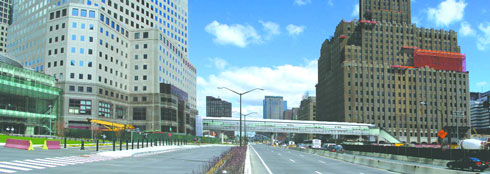By Josh Rogers
Community Board 1, which was once supportive of building a vehicular tunnel along West St. near the World Trade Center site, last week expressed strong doubts about whether the project was worth doing in light of the other transportation needs for Downtown.
“While it wasn’t an explicit rejection, it was 99 percent of what we wanted,” John Dellaportas, a Battery Park City resident who has led the tunnel opposition movement, said of the C.B. 1 resolution. “It couldn’t have been written better ourselves.”
The proposed tunnel between Vesey and Liberty Sts. is the preferred option of Gov. George Pataki, who sees the tunnel as a way to make pedestrian crossings safer and to separate highway traffic away from the W.T.C. memorial.
The estimated cost is $860 million, although city officials are waiting to see the estimates after more detailed engineering studies.
The board resolution, which passed by a margin of 25-10, expressed “serious reservations regarding the cost effectiveness of the West St. bypass….” The board also questioned whether the entrance and exit ramps to the tunnel could create new safety problems and whether the construction disruptions were worth the proposed benefits. The board asked the state Dept. of Transportation to look more closely at less costly options such as traffic calming measures with no tunnel. D.O.T. is studying the at-grade option.
One board member, Bob Grassi, said West St. does pose a hazard, but that doesn’t mean it will be solved with a tunnel.
“Yes it is a barrier but an even bigger barrier will be the memorial that will be 30 feet” below street level, Grassi said.
But Bernard D’Orazio, a member of the board from Tribeca, said one of the opportunities to have come out of the tragedy of the Sept. 11 attack, was the chance to make a smooth connection between the East and Hudson Rivers via Fulton St., and an easy way to cross West St. was the key.
“That is one of the great things to come out of this, and the West St. bypass, as I understand it, will make that a reality,” D’Orazio said.
Tim Carey, president of the Battery Park City Authority, a tunnel proponent, when told of the board’s general concerns, said, “I think they have legitimate questions.”
Carey said he thought the board’s questions about the tunnel would be answered when the engineering studies are complete.
He said that in conjunction with the tunnel, there is likely to be an underground entranceway leading to a bus garage, which has been proposed to be built at one of three sites near or at the W.T.C. Carey said one option under consideration would be an underground passageway going under the West St. tunnel at Vesey St. and leading to the garage. The costs of this aspect of the project would be connected to the garage and not the tunnel, Carey said.
Carey, an appointee and close friend of Pataki, said D.O.T. is not looking at how to build an underground connection to the garage with the at-grade option. In fact, he suggested that D.O.T. really isn’t paying much attention to the no-tunnel alternative at all.
“There’s not an at-grade option,” Carey said. “The governor said he wants a tunnel.”
D.O.T. estimates it could build the tunnel in three years.
In the short term, the Port Authority and D.O.T. are working on improvements to the West St. crossings at Vesey and Liberty Sts. at a cost of $21 million. Work has just begun on a new pedestrian bridge over Vesey to replace the North Bridge which was demolished Sept. 11, 2001.
The bridge is expected to be completed in November to coincide with the opening of the temporary W.T.C. PATH commuter station. A walkway along Vesey St. leading to the bridge will be covered in parts to shield pedestrians from the large construction projects at 7 W.T.C., the Verizon building at 140 West St. and the post office building at Church St.
Carey had expressed concern that the plan would jeopardize pedestrians and make it inconvenient for B.P.C. residents and workers, but he has not yet seen the revised plans with a covered walkway, presented to C.B. 1 last week.
The board reacted favorably to the plan, but expressed concerns about elevators on the new Vesey bridge since the existing Liberty St. elevator hardly worked during the winter and has fared only somewhat better in the summer.
Nick Spaventa, a D.O.T. consultant, assured members that the bridge would have “heavy-duty weather-resistant elevators” with a permanent maintenance contract.
The elevators would open early next year. Between November and then, handicapped people and those pushing strollers would have to cross West St. at street level. Once the bridge became handicapped accessible, the street-level crossing at Vesey St. will be blocked and all pedestrians will be forced to take the bridge, which is also expected to have an escalator built early next year.
At Liberty St., new less steep stairs will be built to make it easier to get to the pedestrian bridge, which reopened last year. The 26-foot increase would be made over a 60-foot distance as opposed to the current 40 feet. Once the new stairs are built, an escalator will replace the old stairs. Officials hope that an escalator will cut into the demand for the Liberty St. lift and limit the mechanical breakdowns next year.
Barry Skolnick, a board member who has been critical of the various agencies and companies responsible for the West St. bridge elevators, said he thought officials were using a Band-Aid solution for the Liberty St. problems.
“I am a little concerned that you are not spending money to rehabilitate the elevators,” said Skolnick.
































